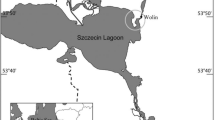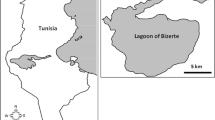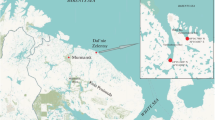Abstract
The limpet Nacella concinna is a dominant macroinvertebrate along the coastal Antarctic Peninsula with two ecotypes inhabiting intertidal and subtidal areas, respectively. The ecological aim of the study was to understand whether higher stress competence and migratory energy expenses in intertidal Antarctic limpets shorten their lifetime and limit the shell growth rate compared to their sublittoral conspecific. We evaluated shell morphometry, age and internal shell growth bands in a large number of intertidal and subtidal N. concinna shells in Potter Cove, South Shetland Islands. Comparisons of their morphometrics showed that intertidal limpets are relatively shorter and less wide, and have higher shell mass, i.e. at common shell height, intertidal shells are relatively thicker and heavier than those of subtidal specimens. Internal shell growth bands showed alternating wide opaque (faster growth in summer) and thin translucent bands (slow growth in winter). The maximum age read was close to 20 years for both groups. Comparisons of von Bertalanffy growth curves showed for shell length and shell width lower growth rate k in intertidal animals than in subtidal ones associated to a great variability, with no differences in other growth parameters. However, when shell height vs. age is considered, no differences were observed for any growth parameter. Curtailed variability of growth rates in the intertidal population reflects either a limitation of the food reserves or feeding time, or an energy gap for shell growth due to the costs for migratory movements and stress defense.





Similar content being viewed by others
References
Abele D, Burlando B, Viarengo A, Pörtner HO (1998) Exposure to elevated temperatures and hydrogen peroxide elicits oxidative stress and antioxidant response in the Antarctic intertidal limpet Nacella concinna. Comp Biochem Physiol B 120:425–435
Abele D, Brey T, Philipp E (2017) Treatise Online No. 92: Part N, Revised, Volume 1, Chapter 7: ecophysiology of extant marine bivalvia. Treatise Online 92, 1–50. Paleontological Institute, University of Kansas, Lindley Hall
Aubone A, Wohler O (2000) Aplicación del método de máxima verosimilitud a la estimación de parámetros y comparación de curvas de crecimiento de von Bertalanffy. Inf. Téc, INIDEP, p 37
Barnes DKA (2002) Polarization of competition increases with latitude. Proc R Soc Lond B 269:2061–2069
Barnes DKA, Kuklinski P (2003) High polar spatial competition: extreme hierarchies at extreme latitude. Mar Ecol Prog Ser 259:17–28
Barnes DKA, Fuentes V, Clarke A et al (2006) Spatial and temporal variation in shallow seawater temperatures around Antarctica. Deep Res II 53:853–865
Brêthes J-C, Ferreyra G, de la Vega S (1994) Distribution, growth and reproduction of the limpet Nacella (Patinigera) concinna (Strebel 1908) in relation to potential food availability, in Esperanza Bay (Antarctic Peninsula). Polar Biol 14:161–170
Cadée GC (1999) Shell damage and shell repair in the Antarctic limpet Nacella concinna from King George Island. J Sea Res 41:149–161
Campana GL, Zacher K, Deregibus D, Momo FR, Wiencke C, Quartino ML (2018) Succession of Antarctic benthic algae (Potter Cove, South Shetland Islands): structural patterns and glacial impact over a four-year period. Polar Biol 41:377–396
Castillo S, de Aranzamendi MC, Martínez JJ, Sahade R (2019) Phenotypic selection by kelp gulls against pear-shaped shells of the Antarctic limpet Nacella concinna. Biol J Linn Soc 128(3):768–777
Cerrato RM (1990) Interpretable statistical tests for growth comparisons using parameters in the von Bertalanffy equation. Can J Fish Aquat Sci 47:1416–1426
Choy EJ, Park H, Kim J-H et al (2011) Isotopic shift for defining habitat exploitation by the Antarctic limpet Nacella concinna from rocky coastal habitats (Marian Cove, King George Island). Estuar Coast Shelf Sci 92:339–346
Clark GF, Stark JS, Johnston EL (2017) Tolerance rather than competition leads to spatial dominance of an Antarctic bryozoan. J Exp Mar Biol Ecol 486:222–229
Clarke A (1996) Marine benthic populations in Antarctica: patterns and processes. Antarct Res Ser 70:373–388
Clarke A, Prothero-Thomas E, Beaumont J et al (2004) Growth in the limpet Nacella concinna from contrasting sites in Antarctica. Polar Biol 28:62–71
Cognie B, Haure J, Barillé L (2006) Spatial distribution in a temperate coastal ecosystem of the wild stock of the farmed oyster Crassostrea gigas (Thunberg). Aquaculture 259:249–259
Colonese AC, Camarós E, Verdún E et al (2011) Integrated archaeozoological research of shell middens: new insights into hunter–gatherer–fisher coastal exploitation in Tierra Del Fuego. J Isl Coast Archaeol 6:235–254
Davenport J (1988) Tenacity of the Antarctic limpet Nacella concinna. J Molluscan Stud 54:355–356
Day EG, Branch GM, Viljoen C (2000) How costly is molluscan shell erosion? A comparison of two patellid limpets with contrasting shell structures. J Exp Mar Biol Ecol 243:185–208
de Aranzamendi MC, Sahade R, Tatián M, Chiappero MB (2008) Genetic differentiation between morphotypes in the Antarctic limpet Nacella concinna as revealed by inter-simple sequence repeat markers. Mar Biol 154:875–885
de Aranzamendi MC, Martinez JJ, Sahade R (2010) Shape differentiation and caracterization in two morphotypes of the Antarctic limpet Nacella concinna using Elliptic Fourir analyses of shells. Polar Biol 33:1163–1170
Edwards AW (1992) Likelihood, expanded edn. Johns Hopkins University Press, Baltimore
Fraser KPP, Clarke A, Peck SL (2007) Growth in the slow lane: protein metabolism in the Antarctic limpet Nacella concinna (Strebel 1908). J Exp Biol 210:2691–2699
Fuchigami T, Sasaki T (2005) The shell structure of the Recent Patellogastropoda (Mollusca: Gastropoda). Paleontol Res 9:143–168
Garcia C (2014) The divergence between ecotypes in a Littorina saxatilis hybrid zone is aligned with natural selection, not with intra-ecotype variation. Evol Ecol 28:793–810
Gleason L, Strand E, Hizon B, Dowd W (2018) Plasticity of thermal tolerance and growth rates in juvenile mussels (Mytilus californianus). Proc R Soc Biol 285:3. https://doi.org/10.1098/rspb.2017.2617
Gosling E (2003) Bivalve molluscs: biology. ecology and culture. Blackwell, Oxford
Heredia Barión P, Lindhorst S, Schutter I et al (2019) Reaction of a polar gravel-spit system to atmospheric warming and glacier retreat as reflected by morphology and internal sediment geometries (South Shetland Islands, Antarctica). Earth Surf Process Landf 44(5):1148–1162
Hilborn R, Mangel M (1997) The ecological detective: confronting models with data. Monographs in Population Biology No. 28. Princeton University Press, Princeton
Hoffman JI, Peck LS, Linse K, Clarke A (2010) Strong oopulation genetic structure in a broadcast-spawning Antarctic marine invertebrate. J Hered 102:55–66
Iken K, Quartino ML, Barrera-Oro E et al (1998) Trophic relations between macroalgae and herbivores. Rep Polar Mar Res 299:258–262
Jones DS, Quitmyer IR, Arnold WS, Marelli DC (1990) Annual shell banding, age, and growth rate of hard clams (Mercenaria spp) from Florida. J Shellfish Res 9:215–225
Kim D (2001) Seasonality of marine algae and grazers of an Antarctic rocky intertidal, with emphasis on the role of the limpet Nacella concinna Strebel (Gastropoda: Patellidae). Berichte zur Polar- und Meersforschung 397
Kochmann J, Buschbaum C, Volkenborn N, Reise K (2008) Shift from native mussels to alien oysters: differential effects of ecosystem engineers. J Exp Mar Biol Ecol 364:1–10
Kremer B, Kazmierczak J, Stal LJ (2008) Calcium carbonate precipitation in cyanobacterial mats from sandy tidal flats of the North Sea. Geobiology 6:46–56
Lindhorst S, Schutter I (2014) Polar gravel beach-ridge systems: sedimentary architecture, genesis, and implications for climate reconstructions (South Shetland Islands/Western Antarctic Peninsula). Geomorphology 221:187–203
Lomovasky BJ, Gutiérrez JL, Iribarne OO (2005) Identifying repaired shell damage and abnormal calcification in the stout razor clam Tagelus plebeius as a tool to investigate its ecological interactions. J Sea Res 54:163–175
Lomovasky BJ, Casariego AM, Brey T, Iribarne O (2006) The effect of the SW Atlantic burrowing crab Chasmagnathus granulatus on the intertidal razor clam Tagelus plebeius. J Exp Mar Biol Ecol 337:19–29
Lomovasky BJ, Brey T, Iribarne O (2018) Distribution pattern, density and growth of the stout razor clam Tagelus plebeius in a South-west Atlantic estuarine system. J Mar Biol Assoc UK 98:485–494
Molis M, Preuss I, Firmenich A, Ellrich J (2011) Predation risk indirectly enhances survival of seaweed recruits but not intraspecific competition in an intermediate herbivore species. J Ecol 99:807–817
Morley SA, Clark MS, Peck LS (2010) Depth gradients in shell morphology correlate with thermal limits for activity and ice disturbance in Antarctic limpets. J Exp Mar Biol Ecol 390:1–5
Moss DK, Ivany LC, Judd EJ et al (2016) Lifespan, growth rate, and body size across latitude in marine bivalvia, with implications for phanerozoic evolution. Proc R Soc B 283:0161364
Nolan CP (1991) Size, shape and shell morphology in the Antarctic limpet Nacella concinna at Signy Island, South Orkey Islands. J Molluscan Stud 57:225–238
Philipp EER, Abele D (2010) Masters of longevity: lessons from long-lived bivalves—a mini-review. Gerontology 56:55–65
Picken GB (1980) The distribution, growth, and reproduction of the Antarctic limpet Nacella (Patinigera) concinna (Strebel 1908). J Exp Mar Biol Ecol 42:71–85
Powell AWB (1951) Antarctic and subantarctic mollusca: Pelecypoda and Gastropoda. Discov Rep 26:47–196
Prendergast AL, Schöne BR (2017) Oxygen isotopes from limpet shells: implications for palaeothermometry and seasonal shellfish foraging studies in the Mediterranean. Palaeogeogr Palaeoclimatol Palaeoecol 484:33–47
Reise K (1998) Pacific oysters invade mussel beds in the European Wadden Sea. Senckenberg marit 28:167–175
Rhoads D, Lutz R (1980) Skeletal growth of aquatic organisms. Plenum Press, New York
Richardson C (2001) Molluscs as archives of environmental change. Oceanogr Mar Biol 39:103–164
Saad A (1997) Age, growth and morphometry of the limpet Cellana eucosmia (Mollusca: Gastropoda) from the Gulf of Suez. Indian J Mar Sci 26:169–172
Schloss IR, Abele D, Moreau S et al (2012) Response of phytoplankton dynamics to 19-year (1991–2009) climate trends in Potter Cove (Antarctica). J Mar Syst 92:53–66
Schöne BR, Dunca E, Fiebig J, Pfeiffer M (2005) Mutvei’s solution: an ideal agent for resolving microgrowth structures of biogenic carbonates. Palaeogeogr Palaeoclimatol Palaeoecol 228:149–166
Shabica SV (1971) General ecology of Antarctic limpet Patinigera polaris. Antarct J US 6:160
Shabica SV (1976) The natural history of the Antarctic limpet Patinigera polaris (Hombron and Jacquinot). PhD Thesis in Philosophy. Oregon State University
Suda CNK, Vani GS, de Oliveira MF et al (2015) The biology and ecology of the Antarctic limpet Nacella concinna. Polar Biol 38:1949–1969
Underwood A (1979) The ecology of intertidal gastropods. Adv Mar Biol 16:111–210
Valdivia N, Scrosati RA, Molis M, Knox AS (2011) Variation in community structure across vertical intertidal stress gradients: how does it compare with horizontal variation at different scales? PLoS ONE 6:1–8
Valdivia N, Díaz MJ, Holtheuer J et al (2014) Up, down, and all around: scale-dependent spatial variation in rocky-shore communities of Fildes Peninsula, King George Island, Antarctica. PLoS ONE 9:1–12
Walker AJM (1972) Introduction to the ecology of the Antarctic limpet Patinigera polaris (Hombron et Jacquinot) at Signy Island, South Orkney Islands. Br Antarct Surv Bull 28:49–69
Waller CL, Barnes DK, Convey P (2006) Ecological contrasts across an Antarctic land–sea interface. Austral Ecol 31(5):656–666
Weihe E, Abele D (2008) Differences in the physiological response of inter- and subtidal Antarctic limpets Nacella concinna to aerial exposure. Aquat Biol 4:155–166
Zar JH (1999) Biostatistical analysis, 4th edn. Prentice-Hall Inc, Englewood Cliffs
Acknowledgements
We want to thank the Instituto Antártico Argentino (IAA) for the logistic support. We are also very grateful to Dr. Cristian Lagger for lending us underwater pictures. We thank the three reviewers (Drs. Juan López-Gappa, Alexey Zotin and Alan Hodgson) for their helpful comments on the manuscript. This work was supported by Grants from the Fondo para la Investigación Científica y Tecnológica, Argentina (FONCyT; PICT-2016–1445 to B. Lomovasky; PICTO-2010–0119 to R. Sahade), and by the EU project 872690 - CoastCarb.
Author information
Authors and Affiliations
Corresponding author
Ethics declarations
Conflict of interest
We declare that we do not have any conflicts of interest.
Additional information
Publisher's Note
Springer Nature remains neutral with regard to jurisdictional claims in published maps and institutional affiliations.
Rights and permissions
About this article
Cite this article
Lomovasky, B.J., de Aranzamendi, M.C. & Abele, D. Shorter but thicker: analysis of internal growth bands in shells of intertidal vs. subtidal Antarctic limpets, Nacella concinna, reflects their environmental adaptation. Polar Biol 43, 131–141 (2020). https://doi.org/10.1007/s00300-019-02615-z
Received:
Revised:
Accepted:
Published:
Issue Date:
DOI: https://doi.org/10.1007/s00300-019-02615-z




